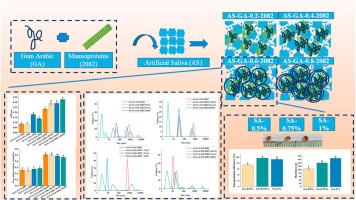阿拉伯胶和甘露蛋白复合物抑制苦味的机理及其在营养吞咽困难凝胶珠中的应用
IF 11
1区 农林科学
Q1 CHEMISTRY, APPLIED
引用次数: 0
摘要
本研究研究了葡萄籽提取物(MOPC)的苦味后味掩蔽机制,并利用阿拉伯胶(GA)-甘露蛋白(2082)复合物开发了一种吞咽困难友好的递送系统。多尺度表征揭示了GA-2082抑制MOPC苦味的机制。结果表明,在最佳浓度(0.6 mg/mL GA)下,与人工唾液(AS)形成稳定的三元配合物是由自由羟基、OH⋯π相互作用和疏水力驱动的。这促进了AS内显色氨基酸折叠和α-螺旋暴露,最终导致密集AS- ga -2082分子网络的形成。这个网络有效地阻碍了MOPC通过唾液膜的渗透。质地分析进一步表明,GA-2082具有较强的舌粘特性,显著降低了MOPC在舌表面的滞留和随后对苦味受体的激活。GA-2082加入海藻酸钠(SA)凝胶珠后,提高了MOPC的包封效率,在SA浓度为0.75%时,包封率最高达到97.68%,同时保持了安全的吞咽特性。这些发现表明GA-2082具有双重功能,既是一种有效的苦味后味掩蔽剂,也是一种生物活性化合物的递送载体,为吞咽困难的治疗提供了一种有前途的营养密集配方。本文章由计算机程序翻译,如有差异,请以英文原文为准。

Mechanism of gum Arabic and mannoprotein complexes in suppressing bitter aftertaste and application in nutritious dysphagia gel beads
This study investigated the bitter aftertaste-masking mechanism of grape seed extract (MOPC) and developed a dysphagia-friendly delivery system using gum Arabic (GA)-mannoproteins (2082) complexes. Multi-scale characterization revealed the mechanism by which GA-2082 suppresses the bitter aftertaste of MOPC. The results demonstrated that at an optimal concentration (0.6 mg/mL GA), the formation of stable ternary complexes with artificial saliva (AS) was driven by free hydroxyl groups, OH⋯π interactions, and hydrophobic forces. This promoted chromogenic amino acid folding and α-helix exposure within AS, ultimately leading to the formation of a dense AS-GA-2082 molecular network. This network effectively hindered the penetration of MOPC through the salivary pellicle. Texture analysis further indicated that GA-2082 exhibited strong tongue-adhesion properties, significantly reducing the retention of MOPC on the tongue surface and subsequent activation of bitter taste receptors. When incorporated into sodium alginate (SA) gel beads, GA-2082 improved the encapsulation efficiency of MOPC, achieving a maximum of 97.68 % at 0.75 % SA concentration, while maintaining safe swallowing characteristics. These findings demonstrated GA-2082 possessed dual functionality as both an effective bitter aftertaste-masking agent and a delivery vehicle for bioactive compounds, providing a promising nutrient-dense formulations for dysphagia management.
求助全文
通过发布文献求助,成功后即可免费获取论文全文。
去求助
来源期刊

Food Hydrocolloids
工程技术-食品科技
CiteScore
19.90
自引率
14.00%
发文量
871
审稿时长
37 days
期刊介绍:
Food Hydrocolloids publishes original and innovative research focused on the characterization, functional properties, and applications of hydrocolloid materials used in food products. These hydrocolloids, defined as polysaccharides and proteins of commercial importance, are added to control aspects such as texture, stability, rheology, and sensory properties. The research's primary emphasis should be on the hydrocolloids themselves, with thorough descriptions of their source, nature, and physicochemical characteristics. Manuscripts are expected to clearly outline specific aims and objectives, include a fundamental discussion of research findings at the molecular level, and address the significance of the results. Studies on hydrocolloids in complex formulations should concentrate on their overall properties and mechanisms of action, while simple formulation development studies may not be considered for publication.
The main areas of interest are:
-Chemical and physicochemical characterisation
Thermal properties including glass transitions and conformational changes-
Rheological properties including viscosity, viscoelastic properties and gelation behaviour-
The influence on organoleptic properties-
Interfacial properties including stabilisation of dispersions, emulsions and foams-
Film forming properties with application to edible films and active packaging-
Encapsulation and controlled release of active compounds-
The influence on health including their role as dietary fibre-
Manipulation of hydrocolloid structure and functionality through chemical, biochemical and physical processes-
New hydrocolloids and hydrocolloid sources of commercial potential.
The Journal also publishes Review articles that provide an overview of the latest developments in topics of specific interest to researchers in this field of activity.
 求助内容:
求助内容: 应助结果提醒方式:
应助结果提醒方式:


